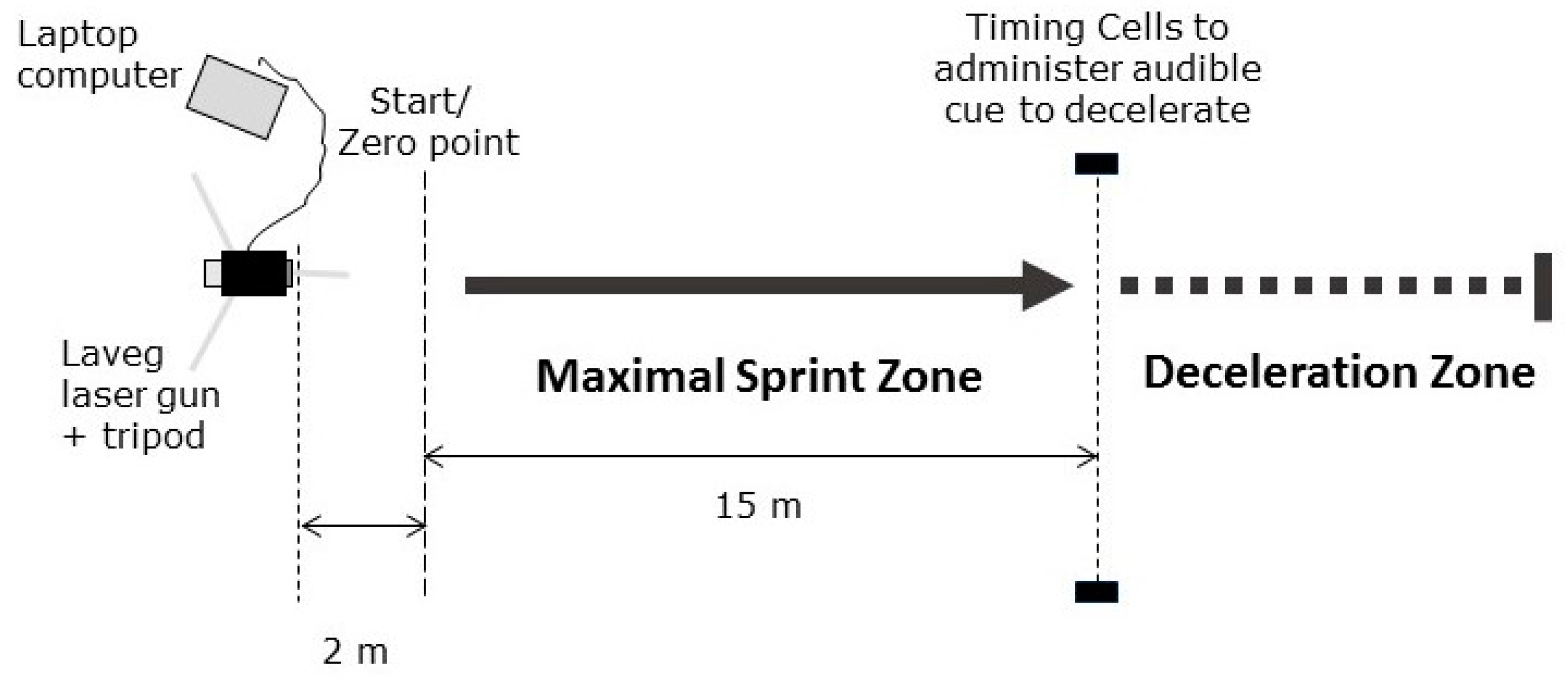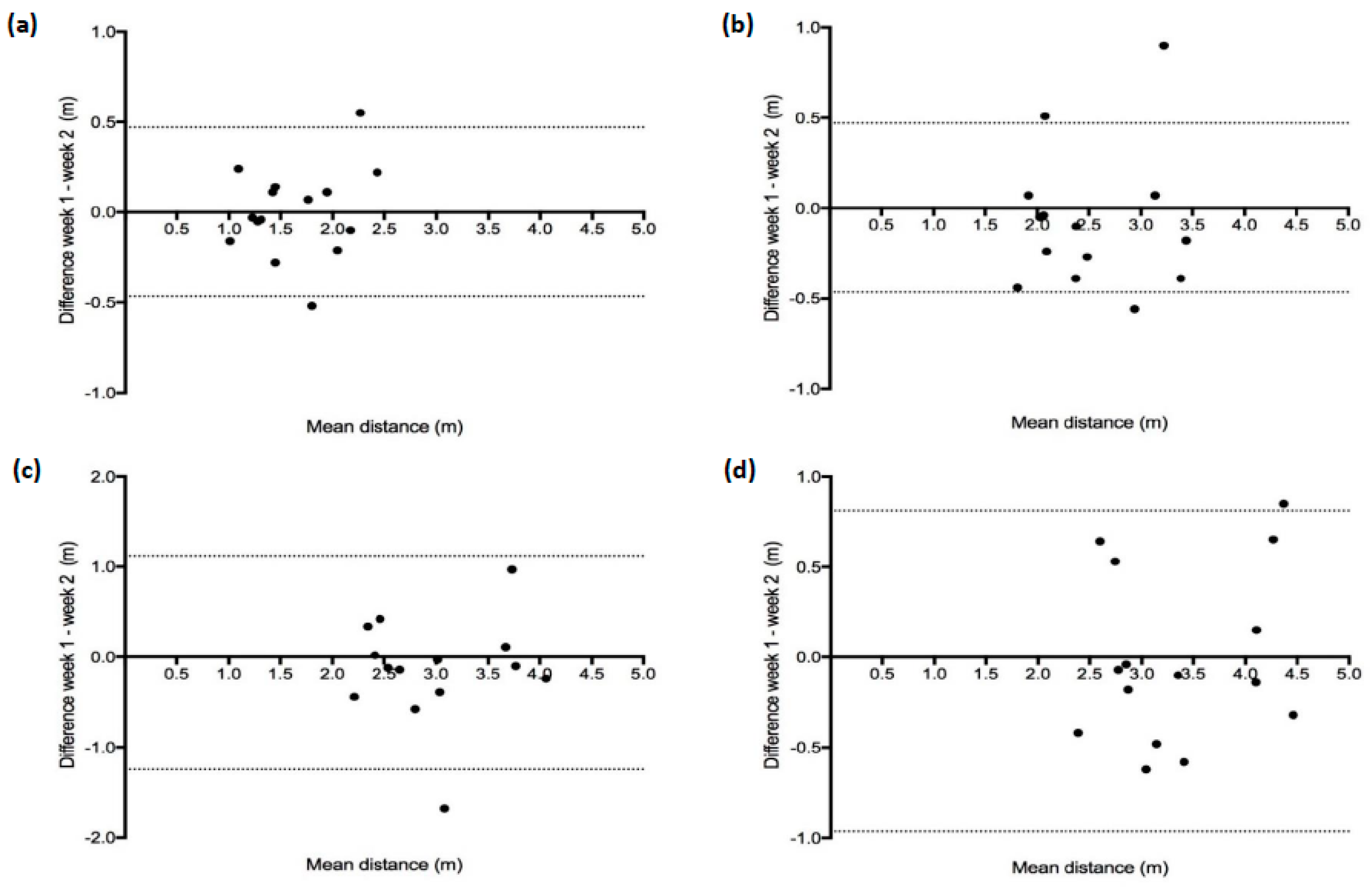The Reliability of Using a Laser Device to Assess Deceleration Ability
Abstract
:1. Introduction
2. Materials and Methods
2.1. Subjects
2.2. Design
2.3. Procedures
2.4. Statistical Analysis
3. Results
3.1. Within-Session Reliability
3.2. Between Session Reliability
4. Discussion
5. Conclusions
Author Contributions
Funding
Acknowledgments
Conflicts of Interest
References
- Hewit, J.; Cronin, J.; Button, C.; Hume, P. Understanding deceleration in sport. Strength Cond. J. 2011, 33, 47–52. [Google Scholar] [CrossRef]
- Russell, M.; Sparkes, W.; Northeast, J.; Cook, C.J.; Love, T.D.; Bracken, R.M.; Kilduff, L.P. Changes in acceleration and deceleration capacity throughout professional soccer match-play. J. Strength Cond. Res. 2016, 30, 2839–2844. [Google Scholar] [CrossRef] [PubMed]
- Tierney, P.J.; Young, A.; Clarke, N.D.; Duncan, M.J. Match play demands of 11 versus 11 professional football using global positioning system tracking: Variations across common playing formations. Hum. Mov. Sci. 2016, 49, 1–8. [Google Scholar] [CrossRef] [PubMed]
- Jones, M.R.; West, D.J.; Crewther, B.T.; Cook, C.J.; Kilduff, L.P. Quantifying positional and temporal movement patterns in professional rugby union using global positioning system. Eur. J. Sport Sci. 2015, 15, 488–496. [Google Scholar] [CrossRef] [PubMed]
- Cunningham, D.; Shearer, D.A.; Drawer, S.; Eager, R.; Taylor, N.; Cook, C.; Kilduff, L.P. Movement demands of elite U20 international rugby union players. PLoS ONE 2016, 11, 1–10. [Google Scholar]
- Nedergaard, N.J.; Kersting, U.; Lake, M. Using accelerometry to quantify deceleration during a high-intensity soccer turning manoeuvre. J. Sports Sci. 2014, 32, 1897–1905. [Google Scholar] [CrossRef] [PubMed]
- Jones, P.A.; Herrington, L.; Graham-Smith, P. Braking characteristics during cutting and pivoting in female soccer players. J. Electromyogr. Kinesiol. 2016, 30, 46–54. [Google Scholar] [CrossRef] [PubMed]
- Dos’Santos, T.; Thomas, C.; Jones, P.A.; Comfort, P. Mechanical determinants of faster change of direction speed performance in male athletes. J. Strength Cond. Res. 2017, 31, 696–705. [Google Scholar] [CrossRef] [PubMed]
- Jones, P.; Thomas, C.; Dos’Santos, T.; McMahon, J.J.; Graham-Smith, P. The role of eccentric strength in 180 turns in female soccer players. Sports 2017, 5, 42. [Google Scholar] [CrossRef] [PubMed]
- Jones, P.; Nimphius, S. Change of direction and agility. In Performance Assessment in Strength and Conditioning; Comfort, P., Jones, P.A., McMahon, J.J., Eds.; Routledge: Abingdon, UK, 2018; pp. 140–165. [Google Scholar]
- Plisk, S. Speed, agility and speed-endurance development. In Essentials of Strength Training and Conditioning, 2nd ed.; Baechle, T.R., Earle, R.W., Eds.; Human Kinetics: Champaign, IL, USA, 2008; pp. 471–491. [Google Scholar]
- Naylor, J.; Greig, M.A. Hierarchical model of factors influencing a battery of agility tests. J. Sports Med. Phys. Fit. 2015, 55, 1329–1335. [Google Scholar]
- Harper, D.; Jordan, A.; Kiely, J. Relationships between eccentric and concentric knee strength capacities and maximal linear deceleration ability in male academy soccer players. J. Strength Cond. Res. 2018, 9, 1–8. [Google Scholar]
- Graham-Smith, P.; Rumpf, M.; Jones, P.A. Assessment of deceleration ability and relationship to approach speed and eccentric strength. In Proceedings of the International Society of Biomechanics in Sport Conference, Auckland, New Zealand, 10–14 September 2018; pp. 8–11. [Google Scholar]
- Vaz, L.; Morais, T.; Rocha, H.; James, N. Fitness profiles of elite Portuguese rugby union players. J. Hum. Kinet. 2014, 41, 235–244. [Google Scholar] [CrossRef] [PubMed]
- Atkinson, G.; Reilly, T. Circadian variation in sports performance. Sport Med. 1995, 21, 292–312. [Google Scholar]
- Weir, J.P. Quantifying test-retest reliability using the intraclass correlation coefficient and the SEM. J. Strength Cond. Res. 2005, 19, 231–240. [Google Scholar] [PubMed]
- Baumgartner, T.A.; Chung, H. Confidence limits for intraclass reliability coefficients. Meas. Phys. Educ. Exerc. Sci. 2001, 5, 179–188. [Google Scholar] [CrossRef]
- Bullock, N.; Martin, D.T.; Ross, A.; Rosemood, C.D.; Jordan, M.J.; Marino, F.E. Acute effect of whole-body vibration on sprint and jumping performance in elite skeleton athletes. J. Strength Cond. Res. 2008, 22, 1371–1374. [Google Scholar] [PubMed]
- Poulos, N.; Kuitunen, S.; Buchheit, M. Effects of preload squatting on sprint performance in adolescent athletes. New Stud. Athl. 2010, 25, 95–103. [Google Scholar]
- Comfort, P.; Graham-Smith, P.; Matthews, M.J.; Bamber, C. Strength and power characteristics in English elite rugby league players. J. Strength Cond. Res. 2011, 25, 1374–1384. [Google Scholar] [CrossRef] [PubMed]
- Schuster, D.; Jones, P.A. Relationships between unilateral horizontal and vertical drop jumps and 20 metre sprint performance. Phys. Sport 2016, 21, 20–25. [Google Scholar]
- Bezodis, N.E.; Kerwin, D.G.; Salo, A. Measurement error in estimates of sprint velocity from a laser displacement measurement device. Int. J. Sports Med. 2012, 33, 439–444. [Google Scholar] [CrossRef]
- Spiteri, T.; Cochrane, J.L.; Hart, N.H.; Haff, G.G.; Nimphius, S. Effect of strength on plant foot kinetics and kinematics during a change of direction task. Eur. J. Sport Sci. 2013, 13, 646–652. [Google Scholar] [CrossRef] [PubMed]
- Aughey, R.J. Applications of GPS technologies to field sports. Int. J. Sports Phys. Perform. 2011, 6, 295–310. [Google Scholar] [CrossRef]
- Fleisig, G.; Chu, Y.; Weber, A.; Andrews, J. Variability in baseball pitching biomechanics among various levels of competition. Sports Biomech. 2009, 8, 10–21. [Google Scholar] [PubMed]


| Session 1 | ||||||
|---|---|---|---|---|---|---|
| Variable | Mean ± SD | 95% CI | ICC | CV | SEM (Abs) | SEM (Rel) |
| (95% CI) | (95% CI) | |||||
| Velocity at 15 m (m·s−1) | 5.36 ± 0.72 | 5.67–5.04 | 0.82 | 5.11% | 0.32 | 6.02% |
| (0.66–0.92) | (3.53–6.69) | |||||
| Distance at 75% of 15 m velocity (m) | 1.69 ± 0.48 | 1.90–1.48 | 0.73 | 14.55% | 0.31 | 18.34% |
| (0.53–0.87) | (10.04–19.06) | |||||
| Distance at 50% of 15 m velocity (m) | 2.78 ± 0.68 | 3.08–2.48 | 0.68 | 11.98% | 0.47 | 16.76% |
| (0.45–0.84) | (8.27–15.69) | |||||
| Distance at 25% of 15 m velocity (m) | 3.07 ± 0.76 | 3.40–2.74 | 0.80 | 12.33% | 0.39 | 12.60% |
| (0.63–0.91) | (8.51–16.15) | |||||
| Distance at 0% of 15 m velocity (m) | 3.58 ± 0.80 | 3.93–3.23 | 0.83 | 10.60% | 0.37 | 10.43% |
| (0.64–0.93) | (7.32–13.88) | |||||
| Session 2 | ||||||
| Velocity at 15 m (m·s−1) | 5.41 ± 0.44 | 5.70–5.12 | 0.83 | 5.48% | 0.30 | 5.48% |
| (0.68–0.92) | (3.78–7.18) | |||||
| Distance at 75% of 15 m velocity (m) | 1.76 ± 0.44 | 1.95–1.57 | 0.83 | 16.71% | 0.23 | 13.06% |
| (0.69–0.92) | (11.53–21.89) | |||||
| Distance at 50% of 15 m velocity (m) | 2.60 ± 0.60 | 2.86–2.34 | 0.68 | 15.93% | 0.45 | 17.25% |
| (0.47–0.84) | (10.99–20.87) | |||||
| Distance at 25% of 15 m velocity (m) | 3.14 ± 0.66 | 3.43–2.85 | 0.64 | 14.77% | 0.54 | 17.08% |
| (0.41–0.82) | (10.19–19.34) | |||||
| Distance at 0% of 15 m velocity (m) | 3.46 ± 0.73 | 3.78–3.14 | 0.82 | 10.51% | 0.38 | 11.08% |
| (0.66–0.92) | (7.25–13.77) | |||||
| Variable | ICC | CV | SEM (Abs) | SEM (Rel) | SDD (Abs) | SDD (Rel) |
|---|---|---|---|---|---|---|
| (95% CI) | (95% CI) | |||||
| Velocity at 15 m (m·s−1) | 0.97 | 1.87% | 0.12 | 2.21% | 0.33 | 6.14% |
| (0.93–0.99) | (2.45–1.29) | |||||
| Distance at 75% of 15 m velocity (m) | 0.93 | 15.63% | 0.12 | 7.04% | 0.34 | 13.19% |
| (0.81–0.98) | (10.79–20.47) | |||||
| Distance at 50% of 15 m velocity (m) | 0.88 | 13.96% | 0.22 | 8.23% | 0.61 | 14.13% |
| (0.67–0.96) | (9.63–18.29) | |||||
| Distance at 25% of 15 m velocity (m) | 0.79 | 13.55% | 0.32 | 10.45% | 0.90 | 11.97% |
| (0.41–0.92) | (9.35–17.75) | |||||
| Distance at 0% of 15 m velocity (m) | 0.91 | 10.55% | 0.23 | 6.54% | 0.64 | 9.11% |
| (0.75–0.97) | (7.28–13.82) |
© 2019 by the authors. Licensee MDPI, Basel, Switzerland. This article is an open access article distributed under the terms and conditions of the Creative Commons Attribution (CC BY) license (http://creativecommons.org/licenses/by/4.0/).
Share and Cite
Ashton, J.; Jones, P.A. The Reliability of Using a Laser Device to Assess Deceleration Ability. Sports 2019, 7, 191. https://doi.org/10.3390/sports7080191
Ashton J, Jones PA. The Reliability of Using a Laser Device to Assess Deceleration Ability. Sports. 2019; 7(8):191. https://doi.org/10.3390/sports7080191
Chicago/Turabian StyleAshton, Jonty, and Paul A. Jones. 2019. "The Reliability of Using a Laser Device to Assess Deceleration Ability" Sports 7, no. 8: 191. https://doi.org/10.3390/sports7080191
APA StyleAshton, J., & Jones, P. A. (2019). The Reliability of Using a Laser Device to Assess Deceleration Ability. Sports, 7(8), 191. https://doi.org/10.3390/sports7080191






